
Melitaea diamina, the false heath fritillary, is a butterfly of the family Nymphalidae.

Boloria is a brush-footed butterfly (Nymphalidae) genus. Clossiana is usually included with it nowadays, though some authors still consider it distinct and it seems to warrant recognition as a subgenus at least.

Erebia is a Holarctic genus of brush-footed butterflies, family Nymphalidae. Most of the about 90–100 species are dark brown or black in color, with reddish-brown to orange or more rarely yellowish wing blotches or bands. These usually bear black spots within, which sometimes have white center spots.

Erebia euryale, the large ringlet, is a species of butterfly belonging to the family Nymphalidae.

The Lapland ringlet is a member of the subfamily Satyrinae of the family Nymphalidae. It is restricted to sunny patches in very damp spruce and pine forests and forested unmanaged peatlands. The larva feeds on various grasses and related plants and winters twice. A dry period in the habitat will result in the decline of the species.

Erebia cassioides, the common brassy ringlet, is a member of the subfamily Satyrinae of family Nymphalidae.

Erebia callias, the Colorado alpine, is a member of the Satyridae subfamily of the Nymphalidae butterflies. It is found in alpine areas of Wyoming and Colorado in the U.S. Rocky Mountains as well as various mountain ranges in eastern Asia.
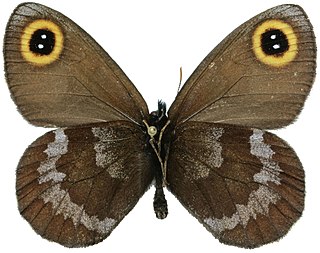
Erebia cyclopius is a species of butterfly of the subfamily Satyrinae in the family Nymphalidae. It is found through Siberia, northern Mongolia, northern China and North Korea. The habitat consists of forest edges, flowery meadows and sparse larch forests.
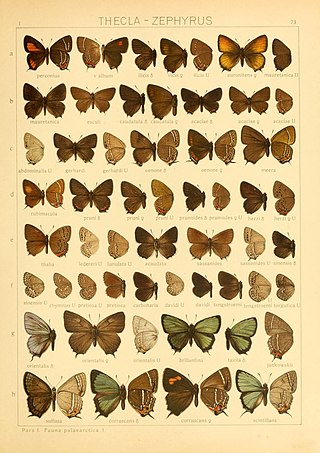
Satyrium prunoides is a butterfly of the family Lycaenidae. It was described by Otto Staudinger in 1887. It is found in the Russian Far East, Mongolia, north-eastern China and Korea.

Pyrgus maculatus is an eastern Palearctic butterfly in the family Hesperiidae and subfamily Pyrginae. The species was first described by Otto Vasilievich Bremer and William Grey in 1853. It is found in South Siberia and Japan. The larva feeds on Spiraea species and Potentilla freyniana.
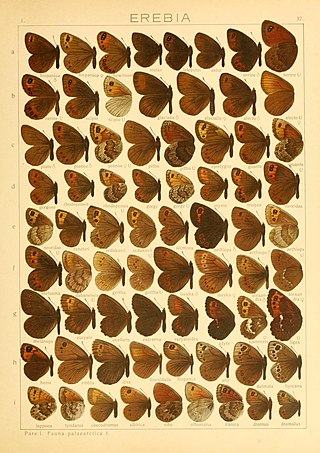
Erebia dabanensis is a small butterfly found in the East Palearctic that belongs to the browns family.
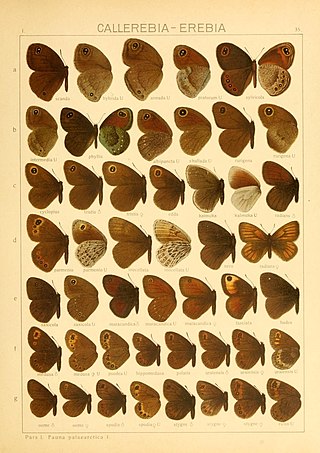
Erebia edda is a small butterfly found in the East Palearctic that belongs to the browns family.

Erebia ajanensis is a butterfly found in the East Palearctic that belongs to the browns family.
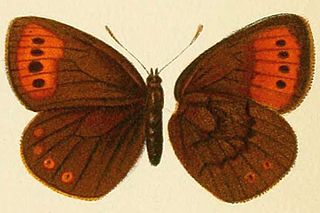
Erebia fletcheri is a butterfly found in the East Palearctic that belongs to the browns family. It resembles Erebia dabanensis but in fletcheri the reddish yellow borders of the ocelli of the forewing are merged on both sides to form a broad russet band. On the hindwing the small ocelli are widely separated from one another. The median band on the underside of the hindwing is dark and somewhat prominent in, while in fletcheri it is of the same dark brown colour as the rest of the wing, so that only the edges of this band are visible as two finely dentate black curved lines. It is found in July between Kurai and Bashkaus.

Erebia theano is a butterfly found in the East Palearctic that belongs to the browns family.

Erebia maurisius is a butterfly found in the East Palearctic that belongs to the browns family.

Erebia kindermanni is a butterfly found in the East Palearctic (Altai) that belongs to the browns family. Subspecies E. k. sarytavica Lukhtanov, 1990 is found in South Altai.

Scabiosa japonica is a species of flowering plant in the pincushion flower genus Scabiosa, native to central and southern Japan, and introduced to the Dominican Republic. A biennial or short-lived perennial reaching 10 to 50 cm, the Royal Horticultural Society considers it a good plant to attract pollinators. A number of cultivars are commercially available, including 'Blue Note', 'Blue Star', 'Blue Diamonds', 'Ritz Blue', and 'Ritz Rose'.

















